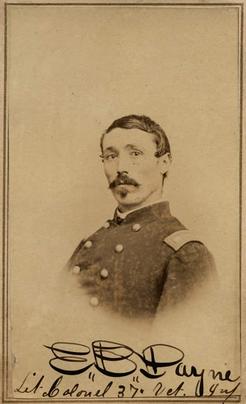Eugene Beauharnais Payne facts for kids
Quick facts for kids
Eugene Beauharnais Payne
|
|
|---|---|

Lt. Col Eugene Beauharnais Payne, 37th Illinois Infantry
|
|
| Born | 15 April 1835 Seneca Falls, New York, US |
| Died | 6 April 1910 Washington, District of Columbia, US |
| Buried | |
| Allegiance | United States of America Union |
| Service/ |
United States Army Union Army |
| Years of service | 1861–1866 |
| Rank | |
| Unit | Company H, Waukegan Zouaves 37th Illinois Volunteer Infantry |
| Battles/wars | American Civil War Pea Ridge Battle of Prairie Grove Siege of Vicksburg Red River Campaign |
| Other work | Illinois House of Representatives |
Eugene Beauharnais Payne (born April 15, 1835 – died April 6, 1910) was an important soldier in the American Civil War. He reached the rank of brevet brigadier general in the Union Army. This was an honorary rank given for brave service. After the war, he became a politician in Illinois.
Contents
Early Life and Education
Eugene Payne was born on April 15, 1835, in Seneca Falls, New York. He might have been named after a famous general, Eugène de Beauharnais. When Eugene was very young, his family moved to Chicago in 1836.
His father, Thomas Hubbard Payne, soon moved the family to Lake County, Illinois. There, they started a business growing and selling trees. Thomas Payne also helped govern the area. He was one of the people who helped choose where the county seat (main town) of Waukegan would be.
Eugene went to the Waukegan Academy. Later, he studied law at Northwestern University. He finished his law degree in 1860 and became a lawyer that same year.
Serving in the Civil War
When the American Civil War began in April 1861, President Abraham Lincoln asked for volunteers. Eugene Payne quickly joined the army. He became a Second Lieutenant in a group called the Waukegan Zouaves. These soldiers were known for their special uniforms and fighting style.
The Waukegan Zouaves went to Camp Yates in Springfield, Illinois. After a short time, many of these volunteers joined new groups for three years of service. Eugene Payne became a Captain in the 37th Illinois Volunteer Infantry. This group was also known as "The Lake County Rifles."
Key Battles and Promotions
Captain Payne fought in the Battle of Pea Ridge. During this battle, he was wounded. Sadly, his younger brother, Frederick Payne, was killed.
Eugene Payne was promoted to major. He then fought in the Battle of Prairie Grove and the Siege of Vicksburg. Sometimes, he even led his entire regiment (a large group of soldiers). After the Siege of Vicksburg, he got sick with malaria. But he got better and returned to duty. He was then promoted to lieutenant colonel.
For his bravery, Eugene Payne received an honorary promotion. He became a brevet colonel and later a brevet brigadier general on March 12, 1865. This made him the first soldier from Lake County to reach such a high rank.
Life After the War
After the Civil War ended, Eugene Payne continued to serve his community. From 1866 to 1870, he was a member of the Illinois House of Representatives. This meant he helped make laws for the state of Illinois. During his second term, he was in charge of the Finance Committee.
He worked as a lawyer in Chicago for many years. However, he had to stop working in 1887 because of poor health. In 1905, he wrote a book about government decisions.
Later in his life, he moved to Cleveland, Ohio. He spent his last years in Washington, D.C., where he passed away in 1910. He is buried at Arlington National Cemetery, a famous burial ground for military heroes.
Family Life and Writings
Eugene Payne married Adelia Theressa Wright in 1862. They had three children: Mary, Daniel, and Charles. He also wrote a book about his experiences in the war. It was called The 37th Illinois Veteran Volunteer Infantry and the battle of Pea Ridge, Arkansas.

